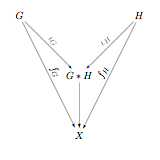Free products of groups
On Tuesday I talked about how to put a group structure on the Cartesian product of two groups, and showed that it satisfied a universal property. For free products I’m just going to start from the property. First, the picture.

This is the same diagram as before, but now it’s upside-down. All the arrows run the other way. So we read this property as follows: Given two groups and
, the free product is a group
with homomorphisms
and
so that given any other group
with homomorphisms
and
there is a unique homomorphism
.
The exact same argument from Tuesday shows that if there is any such group , it is uniquely determined up to isomorphism. What we need is to have an example of a group satisfying this property.
First of all, has to be an monomorphism. Just put
itself for
, the identity on
for
, and the trivial homomorphism (sending everything to the identity) for
. Now anything in the kernel of
is automatically in the kernel of the composition of
with the coproduct map. But this composite is the identity homomorphism on
, which has trivial kernel, and so must
. This means that a copy of
must sit inside
. Similarly a copy of
must sit inside
.
So how do those two copies interact? Let’s put in for
and let
send everything in
to some power of the generator
— effectively defining a homomorphism from
to
— while
sends everything in
to some power of the generator
. If there’s any relation between the copies of
and
sitting inside
, it won’t be respected by the function to
required by the universal property. So there can’t be any such relation.
is actually very much like
, only instead of alternating powers of
and
, we have alternating members of
and
. An arbitrary element looks something like
. Of course it could start with an element of
or end with an element of
. The important thing is that the entries from the two groups alternate. We compose by just sticking sequences together like for a free group. If one sequence ends with an element of
and the next sequence starts with an element of
, we compose those elements in
so the whole sequence is still alternating.
Does sit inside here? Of course! It’s just sequences with only an element of
in them. The same goes for
. And given any group
and homomorphisms
and
, we can send
to
. That’s our
. As I said above, any other group that has this property is isomorphic to
, so we’re done.
If we compare the free product with the direct product
, we see that the main difference is that elements of
and
don’t commute inside
, but they do inside
. We can check that
. In fact, take a presentation of
with generators
and relations
, and one of
with generators
and relations
, and with
and
sharing no elements. Then
has generators
and relations
, while
has generators
and relations
.
Since we’ve only added some relations to the presentation to get from to
, the latter group is a quotient of the former. There should be some epimorphism from
to
. I’ll leave it to you to show that some such epimorphism does exist in two ways: once by the universal property of
and once by the universal property of
.

[…] of diagrams. Check that in this property is satisfied by disjoint unions. In coproducts are free products. In a preorder, coproducts are least upper bounds. And, of course, the coproduct defines a functor […]
Pingback by Products and Coproducts « The Unapologetic Mathematician | December 5, 2007 |
I thought the free product of groups did not necessarily yield a group. I read somewhere that the free product Z(2)*Z(2)(Z(2) = integers mod 2) is not a group. This was in the context of defining the free product from the “bottom up” – strings of representatives with concatenation and reduction. Does that give the same result as your top down method with morphisms etc?
Sorry. I was confusing free products of groups with free groups. Dnnnng!
Right: the product of free groups isn’t a free group. But the free product of free groups is a free group.
“Let’s put F_2 in for X and let f_G send everything in G to the generator a, while f_H sends everything in H to the generator b.”
Surely, then, f_G and f_H are not group homomorphisms? If we have an element g in G, by your definition we have f_G(g) = a, and f_G(g^2) = a, but we should have f_G(g^2) = a^2, which is not equal to a. Also, we can’t map the identity in G to a either. Similarly for H.
Good catch, TC; I was overly glib there. Really I was thinking of sending everything to some expression in involving only one of the generators.
involving only one of the generators.